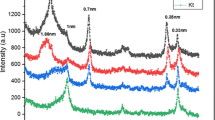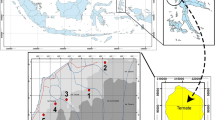Abstract—
The mineralogical composition of nano-clays (NCs), and their potential implications in soil bulk properties of Indian Vertisols are unexplored. In this study, we have isolated NCs (<100 nm) from Deccan basalt (DB) alluvium derived Vertisols (Typic Haplusterts) of central India and characterized them for their mineralogy and crystalline behavior. The soils are clayey (>60%) in texture, rich in smectite mineral (60–80% in <2 μm fraction), alkaline (pH 7.8–8.5), calcareous, and contain <1.0% organic carbon. The clay fraction (<2 μm) is dominated by smectitic NC (40–60%) followed by hydroxy-interlayered vermiculite (HIV), pedogenic chlorite (PCh), kaolinite, and mica. The smectite is little hydroxy-interlayered (HIS), and hydroxy-interlayering is less pronounced in NC smectites than in the coarser clay smectites. The NC smectites are of smaller crystallite size (3.5–5.5 nm) and higher in crystal strain (15–22%) than coarser size clays because of its low lattice charge. The abundance of smectitic NCs considerably reduces the saturated hydraulic conductivity (<1 cm hr–1) of the soils due to high dispersion and swelling (COLE ≥ 0.20) of smectite clays even at the low level of exchangeable sodium percentage (ESP ≤ 5) and a moderate amount of exchangeable magnesium. The report on nano clays (<0.1 μm) highlights the unique role of nano smectites in some selected soil properties, as well as in the origin of SAT Vertisols of the Indian subcontinent.




Similar content being viewed by others
REFERENCES
D. K. Pal, T. Bhattacharyya, P. Chandran, and S. K. Ray, “Linking minerals to selected soil bulk properties and climate change: a review,” Clay Res. 31, 38–69 (2012).
M. Calabi-Floody, J. S. Bendall, A. A. Jara, M. E. Welland, B. K. Theng, C. Rumpel, and M. L. Mora, “Nanoclays from an Andisol: extraction, properties and carbon stabilization,” Geoderma 161, 159–167 (2011).
Z. H. Majeed and M. R. Taha, “A review of stabilization of soils by using nanomaterials,” Aust. J. Basic Appl. Sci. 7, 576–581 (2013).
M. A. Wilson, N. H. Tran, A. S. Milev, G. K. Kannangara, H. Volk, and G. M. Lu, “Nanomaterials in soils,” Geoderma 146, 291–302 (2008).
W. Li, Y. He, J. Wu, and J. Xu, “Extraction and characterization of natural soil nanoparticles from Chinese soils,” Eur. J. Soil Sci. 63, 754–761 (2012).
R. Paul, S. C. Datta, K. M. Manjaiah, and R. Bhattacharyya, “X-ray crystallinity of different soil nanoclays in relation to phosphatase adsorption,” Appl. Clay Sci. 144, 19–25 (2017).
Z. Y. Zhang, L. Huang, F. Liu, M. K.Wang, G. M. Ndzana, and Z. J. Liu, “Transformation of clay minerals in nanoparticles of several zonal soils in China,” J. Soil Sediments 19, 211–220 (2019).
Z. Y. Zhang, L. Huang, F. Liu, M. K. Wang, Q. L. Fu, and J. Zhu, “Characteristics of clay minerals in soil particles of two alfisols in China,” Appl. Clay Sci. 120, 51–60 (2016).
Z. Y. Zhang, L. Huang, F. Liu, M. K. Wang, Q. L. Fu, and J. Zhu, “The properties of clay minerals in soil particles from two Ultisols, China,” Clays Clay Miner. 65, 273–285 (2017).
D. K. Pal, A Treatise of Indian and Tropical Soils (Springer-Verlag, Cham, 2017).
D. K. Pal and S. B. Deshpande, “Characteristics and genesis of minerals in some benchmark Vertisols of India,” Pedologie (Ghent) 37, 259–275 (1987).
T. Bhattacharyya, D. K. Pal, and S. B. Deshpande, “Genesis and transformation of minerals in the formation of red (Alfisols) and black (Inceptisols and Vertisols) soils on Deccan basalt in the Western Ghats,” J. Soil Sci. 44, 159–171 (1993).
D. K. Pal, S. P. Wani, and K. L. Sahrawat, “Vertisols of tropical Indian environments: pedology and edaphology,” Geoderma 189–190, 28–49 (2012).
R. Paul, S. C. Datta, K. M. Manjaiah, and R. Bhattacharyya, “Characterization of nanoclay-phosphatase complex with IR spectroscopy and electron microscopy,” Clay Res. 34, 99–109 (2015).
D. K. Pal, Simple Methods to Study Pedology and Edaphology of Indian Tropical Soils (Springer-Verlag, Berlin, 2019).
A. Mukherjee, R. K. Ray, D. Tewari, V. K. Ingle, B. K. Sahoo, and M. W. Y. Khan, “Revisiting the stratigraphy of the Mesoproterozoic Chhattisgarh Supergroup, Bastar craton, India based on subsurface lithoinformation,” J. Earth Syst. Sci. 123, 617–632 (2014).
Soil Survey Division Staff, Soil Survey Manual: USDA Handbook No. 18, Ed. by C. Ditzler, K. Schette, and H. C. Monger (United States Department of Agriculture, Washington, DC, 2017).
Soil Chemical Analysis: Advanced Course, Ed. by M. L. Jackson (Wiley, Chichester, 1979).
W. M. Schafer and M. J. Singer, “A new method of measuring shrink-swell potential using soil pastes,” Soil Sci. Soc. Am. J. 40, 805–806 (1976).
L. D. Richards, “Diagnosis and improvement of saline and alkali soils,” in USDA Agriculture Handbook No. 60 (US Government Printing Office, Washington DC, 1954).
C. J. Schollenberger and R. H. Simon, “Determination of exchange capacity and exchangeable bases in soil-ammonium acetate method,” Soil Sci. 59, 13–24 (1945).
C. S. Piper “Soil and plant analysis,” (Hans Publishers, Bombay, India, 1966).
A. Klute and C. Dirksen, “Hydraulic conductivity and diffusivity: laboratory measurements,” in Methods of Soil Analysis, Part 1: Physical and Mineralogical Methods, Ed. by A. Klute (Elsevier, Madison, WI, 1986), Chap. 28, pp. 687–734.
O. Gjems, “Studies on clay minerals and clay-mineral formation in soil profiles in Scandinavia,” Medd. Nor. Skogforsoeksves. 21, 303–415 (1967).
S. C. Datta, “Characterization of micaceous minerals in soils for strain and size of crystallites through deconvolution and curve fitting of XRD profile,” Clay Res. 15, 20–27 (1996).
S. C. Datta and T. G. Sastry, “Potassium release in relation to mineralogy of silt and clays,” J. Indian Soc. Soil Sci. 41 (3), 452–458 (1993).
R. C. Reynolds Jr., “Diffraction by small and disordered crystals,” Rev. Miner. Geochem. 20 (1), 145–181 (1989).
S. C. Datta, P. N. Takkar, and U. K. Verma, “Assessing stability of humus in soils from continuous rice-wheat and maize-wheat cropping systems using kinetics of humus desorption,” Commun. Soil Sci. Plant 46, 2888–2900 (2015).
Y. L. Liu, S. H. Yao, X. Z. Han, B. Zhang, and S. A. Banwart, “Soil mineralogy changes with different agricultural practices during 8-year soil development from the parent material of a Mollisol,” Adv. Agron. 142, 143–179 (2017).
H. P. Klug and L. E. Alexander, X-ray Diffraction Procedures, 2nd ed. (Wiley, New York, 1974).
V. Leonid, Elements of X-ray Crystallography (McGraw-Hill, New York, 1968)
B. Velde and P. Barré, “Clay minerals in soils: the interface between plants and the mineral world,” in Soils, Plants and Clay Minerals: Mineral and Biologic Interactions (Springer-Verlag, Berlin, 2010), pp. 129–170.
P. Scherrer, “Bestimmung der inneren Struktur und der Größe von Kolloidteilchen mittels Röntgenstrahlen,” in Kolloidchemie Ein Lehrbuch (Springer-Verlag, Berlin, 1912).
P. R. Kadu, D. K. Pal, and S. B. Deshpande, “Effect of low exchangeable sodium on hydraulic conductivity and drainage in shrink-swell soils of Purna Valley, Maharashtra,” Clay Res. 12, 65–70 (1993).
D. K. Pal, T. Bhattacharyya, P. Chandran, S. K. Ray, P. L. A. Satyavathi, S. L. Durge, P. Raja, and U. K. Maurya, “Vertisols (cracking clay soils) in a climosequence of Peninsular India: evidence for Holocene climate changes,” Quat. Int. 209, 6–21 (2009).
Soil Mineralogy with Environmental Applications, Ed. by J. B. Dixon and D. G. Schulze (Cambridge University Press, Cambridge, 2002).
J. Środoń, “Identification and quantitative analysis of clay minerals,” in Developments in Clay Science (Elsevier, Amsterdam, 2006), Vol. 1, Chap. 12.2, pp. 765–787.
W. E. Wildman, M. L. Jackson, and L. O. Whittig. “Iron-rich montmorillonite formation in soils derived from serpentinite,” Soil Sci. Soc. Am. J. 32, 787–794 (1968).
D. M. Moore and R. C. Reynolds Jr., X-Ray Diffraction and the Identification and Analysis of Clay Minerals (Oxford University Press, Oxford, 1989).
T. A. Sokolova, I. I.Tolpeshta, Y. G. Izosimova, V. A. Umnova, and P. V. Lashukov, “The effect of treatment with hydrogen peroxide and the Mehra–Jackson reagent on X-ray diffraction patterns of clay fractions,” Eurasian Soil Sci. 50, 1386–1394 (2017).
S. W. Buol, F. D. Hole, R. J. McCracken, and R. J. Southard, Soil Genesis and Classification (Wiley, Chichester, 1973).
S. K. Ray, P. Chandran, T. Bhattacharyya, S. L. Durge, and D. K. Pal, “Layer charge of two benchmark Vertisol clays by alkylammonium method,” Clay Res. 22, 13–27 (2003).
G.J. Ross and H. Kodama, “Problems in differentiating soil vermiculites and soil smectites,” in Agronomy Abstracts (American Society of Agronomy, Madison, WI, 1984), p. 275.
F. Hubert, L. Caner, A. Meunier and B. Lanson, “Advances in characterization of soil clay mineralogy using X-ray diffraction: from decomposition to profile fitting,” Eur. J. Soil Sci. 60, 1093–1105 (2009).
J. Calero, J. M. Martín-García, G. Delgado, V. Aranda, and R. Delgado, “A nano-scale study in a soil chronosequence from southern Spain,” Eur. J. Soil Sci. 64, 192–209 (2013).
P. Chandran, S. K. Ray, T. Bhattacharyya, P. Srivastava, P. Krishnan, and D. K. Pal, “Lateritic soils of Kerala, India: their mineralogy, genesis, and taxonomy,” Soil Res. 43, 839–852 (2005).
D. K. Pal, S. P. Wani, K. L. Sahrawat, and P. Srivastava, “Red ferruginous soils of tropical Indian environments: a review of the pedogenic processes and its implications for edaphology,” Catena 121, 260–278 (2014).
D. Das, B. S. Dwivedi, S. P. Datta, S. C. Datta, M. C. Meena, B. K. Agarwal, D. K. Shahi, M. Singh, D. Chakraborty, and S. Jaggi, “Potassium supplying capacity of a red soil from eastern India after forty-two years of continuous cropping and fertilization,” Geoderma 341, 76–92 (2019).
C. I. Rich, “Hydroxy-interlayering in expansible layer silicates,” Clays Clay Miner. 16, 15–30 (1968).
T. Hiemstra, J. Antelo, A. M. D. van Rotterdam and W. H. van Riemsdijk, “Nanoparticles in natural systems II: The natural oxide fraction at interaction with natural organic matter and phosphate,” Geochim. Cosmochim. Acta 74, 59–69 (2010).
Z. Hernández and G. Almendros, “Biogeochemical factors related with organic matter degradation and C storage in agricultural volcanic ash soils,” Soil Biol Biochem. 44, 130–142 (2012).
I. C. Regelink, L. Weng, G. F. Koopmans, and W. H. van Riemsdijk, “Asymmetric flow field-flow fractionation as a new approach to analyse iron-(hydr)oxide nanoparticles in soil extracts,” Geoderma 202, 134–141 (2013).
D. Chatterjee, S. C. Datta, and K. M. Manjaiah, “Clay carbon pools and their relationship with short-range order minerals: avenues to mitigate climate change?” Curr Sci. 105, 1404–1410 (2013).
A. Datta, B. Mandal, S. Badole, K. A. Chaitanya, S. P. Mazumdar, D. Padhan, N. Basak, A. Barman, R. Kundu, and W. N. Narkhede, “Interrelationship of biomass yield, carbon input, aggregation, carbon pools and its sequestration in Vertisols under long-term sorghum-wheat cropping system in semi-arid tropics,” Soil Tillage Res. 184, 164–175 (2018).
G. J. Churchman, M. Askary, P. Peter, M. Wright, M. D. Raven, and P. G. Self, “Geotechnical properties indicating environmental uses for an unusual Australian bentonite,” Appl. Clay Sci. 20, 199–209 (2002).
S. S. Balpande, S. B. Deshpande, and D. K. Pal, “Factors and processes of soil degradation in Vertisols of the Purna valley, Maharashtra, India,” Land Degrad. Dev. 7, 313–324 (1996).
ACKNOWLEDGMENTS
The authors are grateful to Dr. D.K. Pal (Former Principal Scientist and Head, Division of Soil Resource Studies, ICAR NBSS & LUP, Nagpur,India) and Dr. S.C. Datta (Former Emeritus Scientist, Division of Soil Science and Agricultural Chemistry, ICAR-IARI, New Delhi) for providing constructive suggestions to improve the quality of the manuscript.
Funding
Funding and instrumental facilities for this study were provided by the ICAR-National Bureau of Soil Survey and Land Use Planning, Nagpur and by the Science and Engineering Research Board (SERB), Department of Science and Technology (DST), Government of India (ECR/2017/002091).
Author information
Authors and Affiliations
Corresponding author
Ethics declarations
The authors declare no conflict of interest that could have appeared to influence the work reported in this paper.
Supplementary Information
Rights and permissions
About this article
Cite this article
Paul, R., Karthikeyan, K., Vasu, D. et al. Origin and Mineralogy of Nano Clays of Indian Vertisols and Their Implications in Selected Soil Properties. Eurasian Soil Sc. 54, 572–585 (2021). https://doi.org/10.1134/S1064229321040128
Received:
Revised:
Accepted:
Published:
Issue Date:
DOI: https://doi.org/10.1134/S1064229321040128




